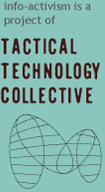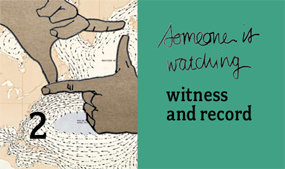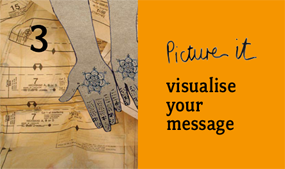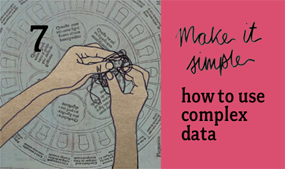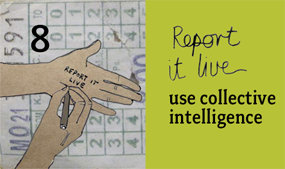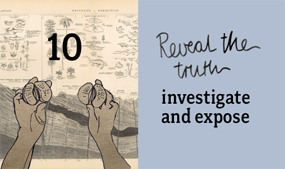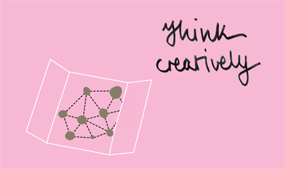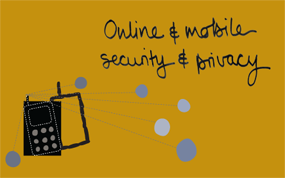|
|
TACTIC 4: PLAN YOUR ACTION
Submitted by richard on Thu, 05/20/2010 - 20:05
NO ONE IS LISTENING
amplify personal stories
download this tactic card (pdf 832kb)

BLANK NOISE
Plan your action
- In the videos of the lives of child soldiers in the Congo, the same story was told in two ways: one story was for local people, to raise awareness, and one was to influence the courts. Think ahead about how the raw material you gather could be crafted to tell different stories for different target audiences.
- For Blank Noise, collecting people's stories and amplifying them on one website created a sense of community for those who contributed. What incentive is there for the people you work with and/or your community to tell a story? How will you support people to stay connected to each other?
- Personal stories can be very revealing. If you ask people to share their stories, you have a responsibility to protect their privacy and safety. When telling a personal story could introduce risks to someone, discuss these risks in detail with them. You may need to conceal people’s identities by excluding their name, location, image, and voice.
- Working with people to tell their stories is in itself a process. Ajedi Ka in the Congo spent months getting to know the children and soldiers before using the video camera. Think about how you will build trust and help people tell their own stories.
- Telling stories online is one form of collective action, but what else might you ask your contributors to do? Will they help lead a campaign in their local area, promote the initiative, create content?
Do it yourselfAsk
- What is your role in the community about which you want to share stories: who are you to them and how will they see you?
- What reward will this community or group get from opening up their personal experiences in front of a larger audience, and what risks might this entail?
- Will you share these personal stories in a closed setting, like a workshop, or will you publish them online for a wide audience who may also republish them in a different context?
- What are the potential privacy and security risks surrounding these stories?
- Is there a timely issue that you can connect the stories to?
- Will the stories you gather be relevant for different audiences, for example, both policy-makers and members of the community?
Different ways you can do this
- Stories can be told with objects as well as words. Blank Noise posted photos of clothing that women were wearing when they were harassed, and also used them in street demonstrations.
- People can tell a personal story anonymously by mobile phone, either with a voice call or a text message. These stories can then be sent from their phones to your campaign, or uploaded directly from their phones, and shared on one website.
- Tagging, or labeling a piece of online content with a keyword, can let you aggregate many stories on one website. You can ask people to upload photos, videos, and blog posts on different websites and all use the same unique tag for these posts. On your website, you can display all the stories with that tag.
- Many people in different regions can each contribute a short video or sequence of photos to make one longer video. This allows people who do not know how to edit video or add music and effects to collaborate over distance.
- For videos where participants cannot show their faces on film, using animation or puppetry, if appropriate for the tone of the video, can still feel very personal.
|
 HTTP://ILOVEMOUNTAINS.ORG/ HTTP://ILOVEMOUNTAINS.ORG/
FEATURED TOOL
Creating a mash-up site:
We the Women’s website pulls many people’s stories from Facebook, Flickr, YouTube and Google News in to one space. If you want to put together a simple website, you can use a free blog, like WordPress, and add content from other websites so that your site updates automatically when new stories are added elsewhere. If you are not working on sensitive issues where content must be moderated before being published, a mash-up site can bring many voices together quickly and simply.
|
TIPS
AREEJ KHAN OF 'WE, THE WOMEN,' ON KEEPING IT LOCAL:
"If I had the chance, I’d have launched the initiative when I was in Saudi Arabia. I’m from there, but some people suggested that I was an outsider because I was living in the United States at the time I began the project. I’ll be going back to Saudi Arabia to continue it."
SALLY-JEAN SHACKLETON OF WOMEN’SNET, ON PERSONAL STORIES:
"This is about people taking ownership over their own stories. It also means that the media is something that we don’t dictate. The media comes from people themselves."
SAM GREGORY OF WITNESS, ON RISK:
"In a digital era, anyone can see a piece of footage, and it just takes one person to make a copy and it could be up online. We encourage people to really think through and understand the potential consequences and to make an informed choice."
|
|
|

